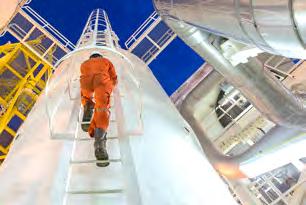
4 minute read
In This Issue
A supply chain time bomb detonates
SAM BARNES
The clock started ticking when the world quite literally shut down in the early days of the COVID-19 pandemic. But not until the economy began returning to normal did the supply chain time bomb detonate in the form of logistical logjams at nearly every stage of the process.
Raw materials, manufacturing, labor, transportation and ultimately the production and delivery of end products are all feeling the pinch. Just ask any auto salesman staring at a half-empty car lot. Or port director watching ships in a line waiting to unload cargo. Or truck fleet manager who can’t find drivers to transport product. Or contractor whose material costs have skyrocketed.
Much like the pandemic, the supply chain problem is impacting everyone.
As a result, industry and the businesses that support them have been forced to pivot from a “just in time” way of doing business to ordering materials months in advance. See “A Shortage of Everything,” beginning on page 16. The trucker shortage has been a particular sore spot. Some petrochemical plants have even delayed production because raw materials simply haven’t arrived.
Last year’s Hurricane Laura got in on the act, of course, decimating U.S. chlorine production when it took out BioLab’s Westlake plant—a vital national supplier of chlorine—and depleting the Lake Charles workforce of contractors and materials. And in Southeast Louisiana, supply chain issues were exponentially amplified by Hurricane Ida in late August.
Experts says supply chain struggles aren’t going away anytime soon but won’t last forever. That’s assuming, of course, that the pandemic ebbs or the world learns to function in the midst of it.
A POSSIBLE SOLUTION
In late August, a record 44 freight ships were stuck waiting for entry into California’s two largest ports— the highest number recorded since the beginning of the COVID-19 pandemic.
And Port of Los Angeles data estimated that a ship’s average wait time had increased to 7.6 days. The queue was caused by labor shortages, COVID 19-related disruptions and holiday buying surges.
Multimodal experts in South Louisiana see opportunity in the West Coast supply struggles. They hope that the widening of the Panama Canal and some very real progress toward opening more container terminals along the Mississippi River will get the attention of suppliers needing to move product directly into the “breadbasket” of the U.S. See “The rise of multimodalism” on page 45.
They’re also wanting to attract more regional distribution centers by touting the multimodal benefits of Southeast Louisiana. Amazon, in fact, is in the early stages of building its 1,000-employee robotics distribution facility, choosing to locate here in part because of the area’s proximity to multiple modes of transportation.
In that same vein, The Port of New Orleans, the Port of Greater Baton Rouge and Port of South Louisiana are positioning themselves for the burgeoning world of container shipping in hopes of luring impatient shippers.
Port NOLA has allocated some $100 million to expand its Napoleon Avenue Container Terminal, and in December moved forward with the purchase of 1,100 acres from the St. Bernard Port for a long-planned, $1.5 billion second container ship terminal in Violet.
The land purchase there kicks off a lengthy two-year period of due diligence to assess the project’s feasibility and potential environmental impacts, followed by several years of design and construction.
And a rapid increase in container volumes prompted the Port of Greater Baton Rouge to increase the size of its container storage facility at Inland Rivers Marine Terminal in 2020.
The $5 million expansion has created nearly 4 acres of additional paved container storage capacity and given the port the ability to store about 2,000 containers.
DRUG USE ON THE RISE
The pandemic continues to color everything in our world these days, or, for some, turn everything to gray.
Drug testing facilities that monitor and test for substance abuse are seeing the pandemic’s impacts in an alarming way: sharp rises in positive drug tests conducted during employee screenings.
See “Red flags are everywhere,” beginning on page 57.
Much of the increase is in the use of anxiety meds, presumably due to heightened worries related to the pandemic, and experts are sounding the alarm bell. These increases in positive drug tests probably mean that more industrial workers are slipping through the cracks, potentially resulting in more safety issues at industrial jobsites.
The time is now for a more proactive approach to drug and mental health counseling, they say. Some industrial owners and contractors have heeded the call, and others, such as the Alliance Safety Council, have proactively offered educational webinars to address the facts and fallacies about COVID-19.
GET SOUTH LOUISIANA INDUSTRY NEWS WEEKLY
10/12 Industry Weekly keeps you apprised of the latest industry news and trends every week. We’re the only newsletter dedicated solely to coverage of South Louisiana’s industrial sector, including oil and gas, petrochemical, manufacturing, supply chain and more. Get 10/12 Industry Weekly delivered to your inbox every Tuesday morning at 5:30 a.m. Get your free subscription at







